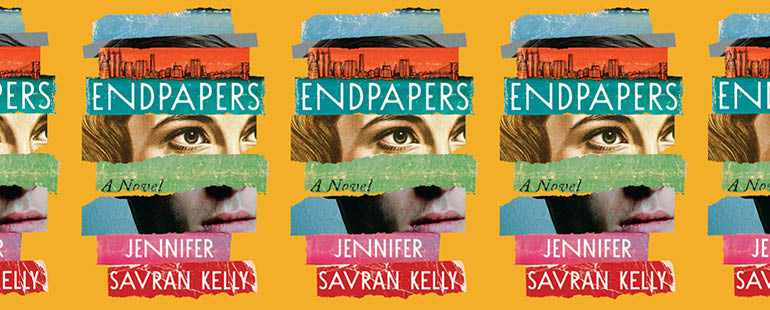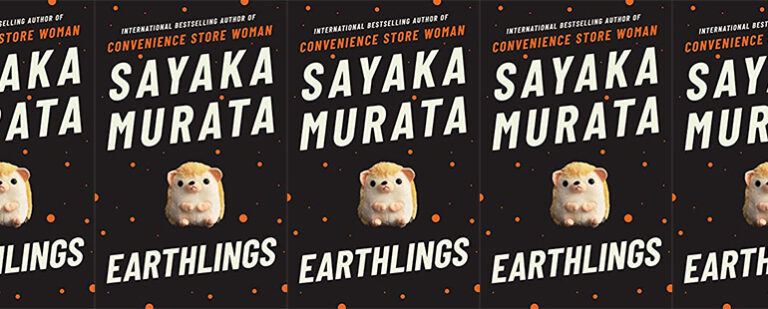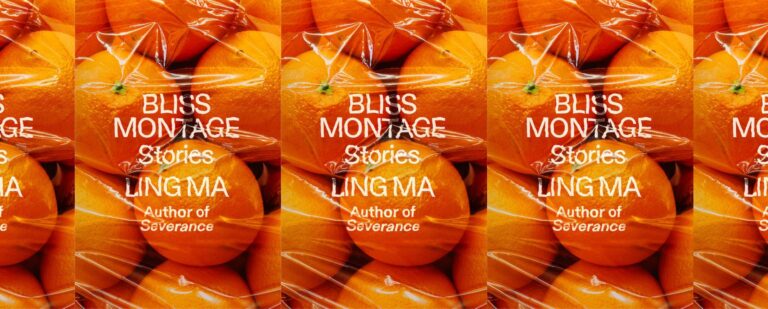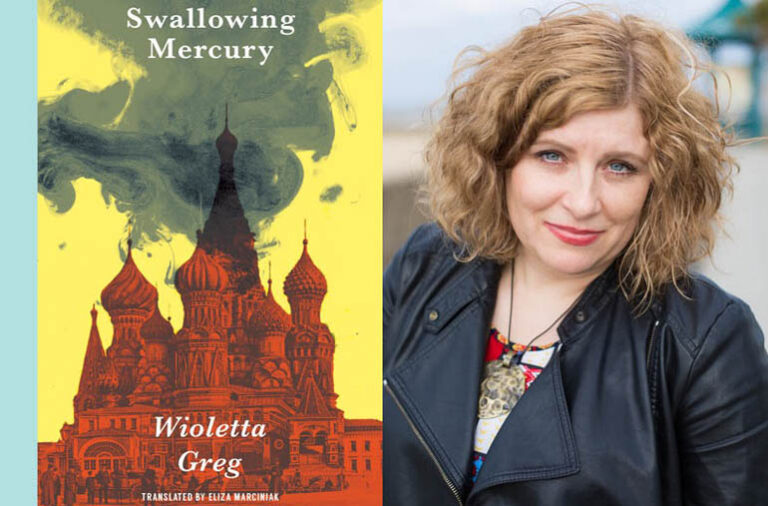Discovery and Re-Discovery in Endpapers

Jennifer Savran Kelly’s Endpapers, out today, is a story of intimate discoveries. The first is that of Dawn, a genderqueer bookbinder living in New York in 2003: she discovers, accepts, and embodies her gender identity and how it affects her entire life, from her romantic relationships to her interactions with her colleagues. The second is a love note written from one young queer woman to another, which Dawn finds inside a book she is repairing, and her attempts to locate the writer or the intended recipient. The third is Dawn’s rediscovery of herself as an artist. These three types of discovery create the interwoven tensions of the novel, which are marked by a near-constant anxiety and uncertainty that reflects both Dawn’s inner turmoil and the book’s setting in a complex post-9/11 New York, where the atmosphere shifts between solidarity and hostility nearly by the hour. All of these different types of instability throw into sharp relief the certainty and authority of the book’s language when Dawn is immersed in her work as a bookbinder, which provides a scaffolding that makes the novel’s hopeful resolution possible. In Kelly’s adept descriptions of the work of Dawn’s hands, the reader is introduced to the possibility of Dawn establishing certainty and confidence in her own life and identity.
It is absolutely telling that Endpapers’s opening lines juxtapose Dawn’s knowledge and precision as a bookbinder with the uncertainties in her own life, positioning the workbench as a source of stability: “Because I’m not ready to go home. Home to Lukas. Because lately I get more pleasure from spreading open the covers of a book than my own legs. Because the pungent spell of ink and the soft touch of paper,” Dawn says. Already, the trouble at home exerts pressure and the environment of bookbinding is made into relief, but this opening doesn’t yet define the specific nature of the dysfunction between Dawn and Lukas—the trouble between them is in many ways as difficult for Dawn to define as it may be for the reader. Instead, the novel pushes the emphasis instead to art: Dawn is desperately trying to reignite her life as a book artist. What she is hoping for is that the project she’s stayed late to work on will be “one that’s finally worthy of exhibiting. Or even one that has anything to say.” The fear that she has nothing to say—as an artist—is intrinsically tied to the novel’s foundational tensions; over and over, Dawn experiences and enacts failures to communicate, to find legibility in her own life.
Here at the start of the novel, as she considers this new project, and later with significantly more urgency when a friend secures her a spot in a prestigious gallery and the clock begins ticking down to the exhibition, Dawn’s surety as a bookbinder is juxtaposed with the instability of everything else. Against the anxiety of what she will find in this new project is absolute steadiness in the practice itself: “Soon my hand is on the heavy wheel of the press, loosening and turning, the iron cool against my fingers…I carry it to my workbench, where I’ve set out thread, dyed tan to match the paper, and black leather sewing tapes, lined with Japanese tissue.” As a bookbinder, she knows exactly what she needs and is comfortable in each of the steps. Through the specificity of the language and the familiarity of the mechanics of the process, the novel establishes Dawn’s fundamental competence in her craft.
This competence is crucial, as it anchors one of the novel’s major touchstones: Dawn does not lack ability, but rather clarity of vision as she pursues the question of “what can happen, what I can make, if I forget everything the world wants to see when it looks at me.” Integral to that question, though, is also Dawn’s own answer: What does Dawn want to see when Dawn looks at Dawn? As a person who is genderqueer and bisexual in the early aughts in New York, Dawn must navigate intense scrutiny and combat critique internally and externally about whether she’s “queer enough” for queer spaces or queer in the “correct” way. In many LGBTQ+ contexts with Lukas, Dawn appears to be heterosexual and cisgender, and she is critiqued as a straight “tourist” in a gay club early in the novel. Her family and her boss, however, view her as too masculine in appearance. When her parents discover her with another girl while Dawn is in high school, she is punished severely by her father; later, the same girlfriend breaks up with her because she accuses Dawn, who is leaning into a butch aesthetic, of trying to be too much like a man. When Dawn dresses in a gender nonconforming way, pairing makeup and a skirt with a button-down and tie, to go out with Lukas and her straight cis man friend Jae who has proposed a drag night, both Lukas and Jae are disappointed—that isn’t masculine enough. These early and current traumatizing experiences—later exacerbated by an incident in which Dawn and Jae are assaulted—make it all the more difficult for Dawn to see herself, and be herself. Every interaction is underpinned by a threat of some kind. That constant unsettling—perceived or actual—takes its toll on Dawn’s interactions.
Because the work is narrated entirely from Dawn’s consciousness and in the present tense, there is no mediating influence to name or frame her reactions or anyone else’s. The result is an intensity of emotion that can veer wildly as Dawn’s learned habit of assuming the worst about others’ judgment of her and her own vacillation about her life and choices collide. These intense reactions are exacerbated by the real troubles at the root of her relationships; Lukas’s constant refusal to express himself—a foundational character trait—lands most devastatingly when Dawn is actively seeking reassurance. These collisions create a fractured image that Dawn herself seems unable to see: after three separate instances of friction and disconnection with Lukas in the first thirty pages of the novel, Dawn says, “Lukas is impossible not to love. He challenges my ideas of what it means to be a good person and makes me believe that all of my sadness and anger are justified.” This is only a few pages after he seems indifferent to her excitement about finding the love letter beneath the endpapers of the book she is repairing, but she doesn’t see the dissonance in the moment. Not long after, after a demoralizing day, Dawn takes her frustrations out on Lukas; quickly and repeatedly, the foundational structure of their connection to each other renders only blurrily—first to the reader, and then, eventually, to Dawn. She thinks about ending things with him many times before actually doing so. In the exact moment at which she discovers the love letter, though, she is decisive and assured.
Even though, at the moment of discovery, Dawn is ruminating on her boss’s critique of her appearance, she sets to work with clear purpose and action. Her task is to repair a book with some minor water damage, and even while the devastating mantra of how she should look rolls through her mind—“More feminine. Less depressed.”—that shakiness never touches her hands: “Slowly, I pass my lifting knife under the freshly cut edge to ease it away from the board as I hold the cover steady. That’s when I notice a discrepancy in the feel of the board…A few more strokes of the knife and I’m able to jiggle it free, leaving only one tiny tear behind.” Though there is that “one tiny tear”—testament to her choice to discover whatever is hidden—there is no agonizing over the choice to do it. A few minutes later, when Dawn decides to take the love letter, written in German on the back of a pulpy lesbian paperback cover, rather than log it and preserve it in the collection, she does not hesitate. Even without being able to read the letter’s text, Dawn knows it is and will be important to her and acts accordingly.
This pattern continues throughout the novel, small moments of triumph and clarity connecting with particular acts as a maker that magnify in significance and scope as the deadline for the exhibition approaches. She decides to take a collaborative approach to her exhibition, which will focus on non-normative bodies. This, too, is progress, as she has spent much of her life either rejecting or being rejected by various kinds of community. She takes a chance and reconnects with her ex-girlfriend Alice, who is a street artist known for the little eyes she embeds in various public spaces. Alice introduces Dawn to other artists who understand Dawn’s focus on nonnormative bodies in a way Dawn does not expect: with a fundamentally gender-nonconforming approach. The implication is that Dawn—as an artist, as a person—has found people who fully see her.
It feels fitting, then, that the moment at which Dawn lands on the final element for her exhibition project dovetails with her decision to end things with Lukas. After another instance in which Dawn craves reassurance—specifically, a declared I love you after the tumult of her and Jae’s assault and Dawn kissing Alice—and doesn’t get it, she leaves and takes refuge in a bindery where she’d been an intern. There, alone, in the middle of the night, in the sea of finally understanding that this relationship cannot be salvaged, she finds solace and inspiration: “My breath calms as I begin to fold [a large sheet of paper] into a signature, the tool molding into the palm of my hand while I reshape the empty expanse into a less intimidating size.” As her artistic foray continues, she integrates the sender of the love letter into the piece, bringing together the threads of the story as both object and metaphor. This is the anchor to her exhibit, and though the actual exhibition takes place after the close of the novel, the important work has been done: Dawn has created artistic legibility for herself and found something to say. While she shapes that paper beneath—or despite—her sorrow, she is also doing so in the context of community and collaboration, and, the reader intuits, bringing the largeness of her own emotional landscape into a shape she can hold and manage.


